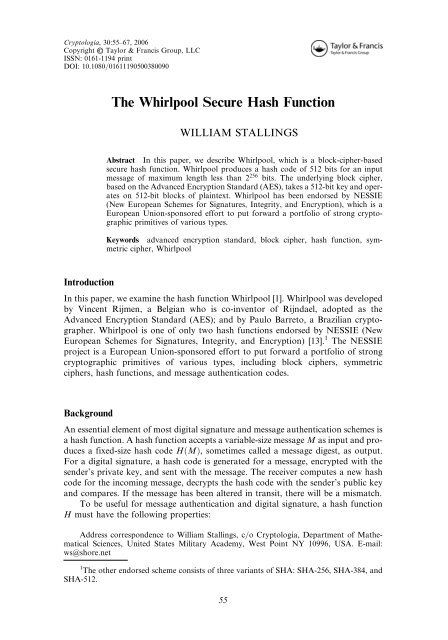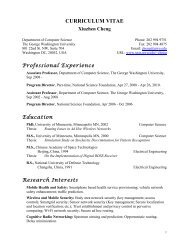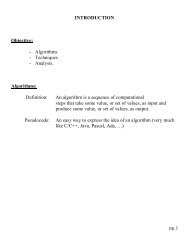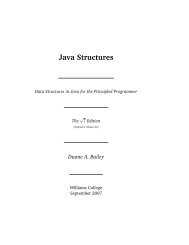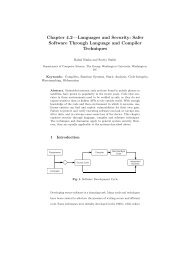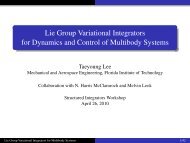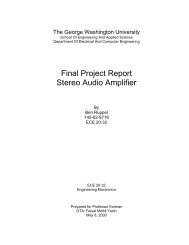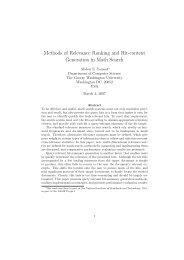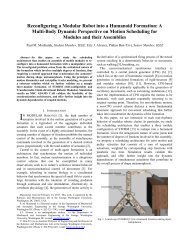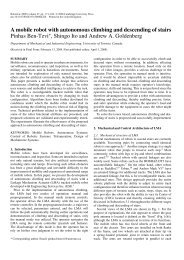The Whirlpool Secure Hash Function - SEAS
The Whirlpool Secure Hash Function - SEAS
The Whirlpool Secure Hash Function - SEAS
Create successful ePaper yourself
Turn your PDF publications into a flip-book with our unique Google optimized e-Paper software.
Cryptologia, 30:55–67, 2006<br />
Copyright Taylor & Francis Group, LLC<br />
ISSN: 0161-1194 print<br />
DOI: 10.1080/01611190500380090<br />
Introduction<br />
<strong>The</strong> <strong>Whirlpool</strong> <strong>Secure</strong> <strong>Hash</strong> <strong>Function</strong><br />
WILLIAM STALLINGS<br />
Abstract In this paper, we describe <strong>Whirlpool</strong>, which is a block-cipher-based<br />
secure hash function. <strong>Whirlpool</strong> produces a hash code of 512 bits for an input<br />
message of maximum length less than 2 256 bits. <strong>The</strong> underlying block cipher,<br />
based on the Advanced Encryption Standard (AES), takes a 512-bit key and operates<br />
on 512-bit blocks of plaintext. <strong>Whirlpool</strong> has been endorsed by NESSIE<br />
(New European Schemes for Signatures, Integrity, and Encryption), which is a<br />
European Union-sponsored effort to put forward a portfolio of strong cryptographic<br />
primitives of various types.<br />
Keywords advanced encryption standard, block cipher, hash function, symmetric<br />
cipher, <strong>Whirlpool</strong><br />
In this paper, we examine the hash function <strong>Whirlpool</strong> [1]. <strong>Whirlpool</strong> was developed<br />
by Vincent Rijmen, a Belgian who is co-inventor of Rijndael, adopted as the<br />
Advanced Encryption Standard (AES); and by Paulo Barreto, a Brazilian cryptographer.<br />
<strong>Whirlpool</strong> is one of only two hash functions endorsed by NESSIE (New<br />
European Schemes for Signatures, Integrity, and Encryption) [13]. 1 <strong>The</strong> NESSIE<br />
project is a European Union-sponsored effort to put forward a portfolio of strong<br />
cryptographic primitives of various types, including block ciphers, symmetric<br />
ciphers, hash functions, and message authentication codes.<br />
Background<br />
An essential element of most digital signature and message authentication schemes is<br />
a hash function. A hash function accepts a variable-size message M as input and produces<br />
a fixed-size hash code HðMÞ, sometimes called a message digest, as output.<br />
For a digital signature, a hash code is generated for a message, encrypted with the<br />
sender’s private key, and sent with the message. <strong>The</strong> receiver computes a new hash<br />
code for the incoming message, decrypts the hash code with the sender’s public key<br />
and compares. If the message has been altered in transit, there will be a mismatch.<br />
To be useful for message authentication and digital signature, a hash function<br />
H must have the following properties:<br />
Address correspondence to William Stallings, c=o Cryptologia, Department of Mathematical<br />
Sciences, United States Military Academy, West Point NY 10996, USA. E-mail:<br />
ws@shore.net<br />
1<br />
<strong>The</strong> other endorsed scheme consists of three variants of SHA: SHA-256, SHA-384, and<br />
SHA-512.<br />
55
56 W. Stallings<br />
1. H can be applied to a block of data of variable size.<br />
2. H produces a fixed-length output.<br />
3. HðxÞ is relatively easy to compute for any given x, making both hardware and<br />
software implementations practical.<br />
4. For any given value h, it is computationally infeasible to find x such that<br />
H(x) ¼ h. This is sometimes referred to in the literature as the one-way property.<br />
5. For any given block x, it is computationally infeasible to find y 6¼ x such that<br />
HðyÞ ¼HðxÞ. This is sometimes referred to as weak collision resistance.<br />
6. It is computationally infeasible to find any pair ðx; yÞ such that HðxÞ ¼HðyÞ.<br />
This is sometimes referred to as strong collision resistance.<br />
<strong>The</strong> general iterated hash structure proposed by Merkle [8] and Damgard [3] is<br />
used in virtually all secure hash functions. <strong>The</strong> hash algorithm involves repeated use<br />
of a compression function, f , which takes two inputs (an n-bit input from the previous<br />
step, called the chaining variable, andab-bit block) and produces an n-bit output. At<br />
the start of hashing, the chaining variable has an initial value that is specified as part<br />
of the algorithm. <strong>The</strong> final value of the chaining variable is the hash value. Often,<br />
b > n; hence the term compression. <strong>The</strong> hash function can be summarized as follows:<br />
CV0 ¼ IV ¼ initial n-bit value<br />
CVi ¼ f ðCVi<br />
HðMÞ ¼CVL<br />
1; Yi 1Þ; 1 i L<br />
where the input to the hash function is a message M consisting of the blocks<br />
Y0; Y1; ...; YL 1.<br />
<strong>The</strong> motivation for this iterative structure stems from the observation by Merkle<br />
[8] and Damgard [3] that if the compression function is collision resistant, then so is<br />
the resultant iterated hash function. <strong>The</strong>refore, the structure can be used to produce<br />
a secure hash function to operate on a message of any length. <strong>The</strong> problem of designing<br />
a secure hash function reduces to that of designing a collision-resistant compression<br />
function that operates on inputs of some fixed size.<br />
Most of the published proposals for hash functions fall into one of two categories:<br />
those based on the use of a block cipher for the compression function, and<br />
those based on the use of a compression function specifically designed for the hash<br />
function. In either case, it is difficult to design a hash function that is secure [5, 9, 10].<br />
To appreciate this difficulty, it is worthwhile to summarize some recent history<br />
of hash functions. MD4, developed by Ron Rivest, one of the designers of the RSA<br />
public-key algorithm, was introduced in 1990 and became quite popular. However,<br />
some weaknesses were discovered in MD4 and Rivest soon replaced it with a more<br />
complex version, called MD5. Both MD4 and MD5 produce a 128-bit hash code.<br />
Rivest conjectured that MD5 is as strong as possible for a 128-bit hash code; namely,<br />
the difficulty of coming up with two messages having the same message digest is on<br />
the order of 2 64 operations, whereas the difficulty of finding a message with a given<br />
digest is on the order of 2 128 operations. A series of increasingly sophisticated attacks<br />
on MD4 and MD5 (e.g., [4], [21]), however, led RSA Laboratories, where Rivest<br />
developed MD4 and MD5, to recommend phasing out these algorithms in favor<br />
of the <strong>Secure</strong> <strong>Hash</strong> Algorithm (SHA) family [15].<br />
SHA was developed by the National Institute of Standards and Technology<br />
(NIST) and published as a federal information processing standard (FIPS 180) in
1993. SHA has a hash length of 160 bits. Thus, from the point of view of brute-force<br />
attack, it is stronger than MD5: <strong>The</strong> difficulty of finding a message with a given<br />
digest using a brute-force attack is 2 160 . When weaknesses were discovered in<br />
SHA, a revised version was issued as FIPS 180–1 in 1995 and is generally referred<br />
to as SHA-1. SHA is based on the hash function MD4 and its design closely models<br />
MD4. SHA-1 produces a hash value of 160 bits. In 2002, NIST produced a revised<br />
version of the standard, FIPS 180–2, that defined three new versions of SHA, with<br />
hash value lengths of 256, 384, and 512 bits, known as SHA-256, SHA-384, and<br />
SHA-512. <strong>The</strong>se new versions have the same underlying structure and use the same<br />
types of modular arithmetic and logical binary operations as SHA-1. In 2005, NIST<br />
announced the intention to phase out approval of SHA-1 and move to a reliance on<br />
the other SHA versions by 2010. Shortly thereafter, a research team described an<br />
attack in which two separate messages could be found that deliver the same SHA-1<br />
hash using 2 69 operations, far fewer than the 2 80 operations previously thought<br />
needed to find a collision with an SHA-1 hash [22]. This result should hasten the<br />
transition to the other versions of SHA [16].<br />
Given the difficulties encountered with this whole line of hash functions based<br />
on essentially the same compression function model, it makes sense to investigate<br />
the use of a block-cipher based hash function with a strong cipher as its base.<br />
Preneel [14, 11] performed a systematic analysis of block-cipher-based hash functions.<br />
In this study, the hash code length equals the cipher block length. Additional<br />
security problems are introduced and the analysis is more difficult if the hash code length<br />
exceeds the cipher block length. Preneel devised 64 possible permutations of the basic<br />
model, based on which input served as the encryption key and which served as plaintext<br />
and what input, if any, was combined, using XOR, with the ciphertext to produce the<br />
intermediate hash code. Based on his analysis, he concluded that only schemes in which<br />
the plaintext was combined with the ciphertext were secure. Such an arrangement makes<br />
the compression function difficult to invert. Confirmation of these results are reported in<br />
[2], but the authors pointed out the security problem of using an established block cipher<br />
such as AES: <strong>The</strong> 128-bit hash code value resulting from the use of AES or another<br />
scheme with the same block size may be inadequate for security.<br />
<strong>The</strong> <strong>Whirlpool</strong> Approach<br />
<strong>The</strong> <strong>Whirlpool</strong> <strong>Secure</strong> <strong>Hash</strong> <strong>Function</strong> 57<br />
<strong>Whirlpool</strong> is based on the use of a block cipher for the compression function. <strong>The</strong>re<br />
has traditionally been little interest in the use of block-cipher-based hash functions<br />
because of the demonstrated security vulnerabilities of the structure. <strong>The</strong> following<br />
are potential drawbacks:<br />
1. Block ciphers typically exhibit certain regularities or weaknesses. For example,<br />
[10] demonstrates how to compromise many hash schemes based on properties<br />
of the underlying block cipher.<br />
2. Typically, block-cipher-based hash functions are significantly slower than hash functions<br />
based on a compression function specifically designed for the hash function.<br />
3. A principal measure of the strength of a hash function is the length of the hash<br />
code in bits. For block-cipher-based hash codes, proposed designs have a hash<br />
code length equal to either the cipher block length or twice the cipher block<br />
length. Traditionally, cipher block length has been limited to 64 bits (e.g.,<br />
DES, triple DES), resulting in a hash code of questionable strength.
58 W. Stallings<br />
Since the adoption of AES, however, there has been renewed interested in developing<br />
a secure hash function based on a strong block cipher and exhibiting good performance.<br />
<strong>Whirlpool</strong> is a block-cipher-based hash function intended to provide<br />
security and performance that is comparable, if not better, than that found in nonblock-cipher<br />
based hash functions, such as SHA. <strong>Whirlpool</strong> has the following features:<br />
1. <strong>The</strong> hash code length is 512 bits, equaling the longest hash code available with SHA.<br />
2. <strong>The</strong> overall structure of the hash function is one that has been shown to be resistant<br />
to the usual attacks on block-cipher-based hash codes [2, 14].<br />
3. <strong>The</strong> underlying block cipher is based on AES and is designed to provide for<br />
implementation in both software and hardware that is both compact and exhibits<br />
good performance.<br />
<strong>The</strong> security goals for <strong>Whirlpool</strong>, as stated on their Web site (http:==paginas.<br />
terra.com.br=informatica=paulobarreto=<strong>Whirlpool</strong>Page.html), can be expressed as<br />
follows. Assume we take as hash result the value of any n-bit substring of the full<br />
<strong>Whirlpool</strong> output. <strong>The</strong> design of <strong>Whirlpool</strong> sets the following security goals:<br />
. <strong>The</strong> expected workload of generating a collision is of the order of 2n=2 executions<br />
of <strong>Whirlpool</strong>.<br />
. Given an n-bit value, the expected workload of finding a message that hashes to<br />
that value is of the order of 2n executions of <strong>Whirlpool</strong>.<br />
. Given a message and its n-bit hash result, the expected workload of finding a<br />
second message that hashes to the same value is of the order of 2n executions of<br />
<strong>Whirlpool</strong>.<br />
. It is infeasible to detect systematic correlations between any linear combination of<br />
input bits and any linear combination of bits of the hash result, or to predict what<br />
bits of the hash result will change value when certain input bits are flipped (this<br />
means resistance against linear and differential attacks) [12].<br />
<strong>The</strong> designers assert their confidence that these claims have been met with a considerable<br />
safety margin. However, a formal proof of these claims has not been<br />
achieved.<br />
We begin with a discussion of the structure of the overall hash function, and<br />
then examine the block cipher used as the basic building block.<br />
<strong>Whirlpool</strong> <strong>Hash</strong> Structure<br />
<strong>Whirlpool</strong> Logic<br />
Given a message consisting of a sequence of blocks m1; m2; ...; mt, the <strong>Whirlpool</strong><br />
hash function is expressed as follows:<br />
H0 ¼ initial value.<br />
Hi ¼ EðHi 1; miÞ Hi 1 mi ¼ intermediate value:<br />
Ht ¼ hash code value:<br />
<strong>The</strong> encryption key input for each iteration i is the intermediate hash Hi 1<br />
value from the previous iteration, and the plaintext is the current message block mi.<br />
<strong>The</strong> output for this iteration ðHiÞ consists of the bitwise XOR of the current message<br />
block, the intermediate hash value from the previous iteration, and the output from W.
<strong>The</strong> algorithm takes as input a message with a maximum length of less than<br />
2256 bits and produces as output a 512-bit message digest. <strong>The</strong> input is processed<br />
in 512-bit blocks. Figure 1 depicts the overall processing of a message to produce<br />
a digest. <strong>The</strong> processing consists of the following steps:<br />
. Step 1: Append padding bits. <strong>The</strong> message is padded so that its length in bits is an<br />
odd multiple of 256. Padding is always added, even if the message is already of the<br />
desired length. For example, if the message is 256 3 ¼ 768 bits long, it is padded<br />
by 512 bits to a length of 256 5 ¼ 1;280 bits. Thus, the number of padding bits is<br />
in the range of 1 to 512.<br />
<strong>The</strong> padding consists of a single 1-bit followed by the necessary number of<br />
0-bits.<br />
. Step 2: Append length. A block of 256 bits is appended to the message. This block<br />
is treated as an unsigned 256-bit integer (most significant byte first) and contains<br />
the length in bits of the original message (before the padding).<br />
<strong>The</strong> outcome of the first two steps yields a message that is an integer multiple of<br />
512 bits in length. In Figure 1, the expanded message is represented as the<br />
sequence of 512-bit blocks m1; m2; ...; mt, so that the total length of the expanded<br />
message is t 512 bits. <strong>The</strong>se blocks are viewed externally as arrays of bytes by<br />
sequentially grouping the bits in 8-bit chunks. However, internally, the hash state<br />
Hi is viewed as an 8 8 matrix of bytes. <strong>The</strong> transformation between the two is<br />
explained subsequently.<br />
. Step 3: Initialize hash matrix. An 8 8 matrix of bytes is used to hold intermediate<br />
and final results of the hash function. <strong>The</strong> matrix is initialized as consisting of all<br />
0-bits.<br />
. Step 4: Process message in 512-bit (64-byte) blocks. <strong>The</strong> heart of the algorithm is<br />
the block cipher W.<br />
Block Cipher W<br />
<strong>The</strong> <strong>Whirlpool</strong> <strong>Secure</strong> <strong>Hash</strong> <strong>Function</strong> 59<br />
Figure 1. Message digest generation using <strong>Whirlpool</strong>. Note: triangular hatch marks key input.<br />
Unlike virtually all other proposals for a block-cipher-based hash function, <strong>Whirlpool</strong><br />
uses a block cipher that is specifically designed for use in the hash function
60 W. Stallings<br />
Table 1. Comparison of <strong>Whirlpool</strong> block cipher W and AES<br />
W AES<br />
Block size (bits) 512 128<br />
Key size (bits) 512 128, 192, or 256<br />
Matrix orientation input is mapped row-wise Input is mapped column-wise<br />
Number of rounds 10 10, 12, or 14<br />
Key expansion W round function dedicated expansion algorithm<br />
GFð28Þ polynomial x8 þ x4 þ x3 þ x2 þ 1 (011D) x8 þ x4 þ x3 þ x þ 1 (011B)<br />
Origin of S-box recursive structure multiplicative inverse<br />
in GFð28Þ plus<br />
affine transformation<br />
Origin of round successive entries of the S-box elements 2i of GFð28Þ constants<br />
Diffusion layer right multiplication by<br />
8 8 circulant MDS matrix<br />
(1, 1, 4, 1, 8, 5, 2, 9) -<br />
mix rows<br />
Permutation shift columns shift rows<br />
left multiplication by<br />
4 4 circulant<br />
MDS matrix (2, 3, 1, 1) -<br />
mix columns<br />
and that is unlikely ever to be used as a standalone encryption function. <strong>The</strong> reason<br />
for this is that the designers wanted to make use of a block cipher with the security<br />
and efficiency of AES but with a hash length that provided a potential security equal<br />
to SHA-512. <strong>The</strong> result is the block cipher W, which has a similar structure and uses<br />
the same elementary functions as AES [20], but which uses a block size and a key size<br />
of 512 bits. Table 1 compares AES and W.<br />
Although W is similar to AES, it is not simply an extension. In fact, AES is one<br />
version of the cipher Rijndael, which was submitted as a candidate for the AES. <strong>The</strong><br />
Rijndael proposal for AES defined a cipher in which the block length and the key<br />
length can be independently specified to be 128, 192, or 256 bits. <strong>The</strong> AES specification<br />
uses the same three key size alternatives but limits the block length to 128 bits.<br />
AES operates on a state of 4 4 bytes. Rijndael with block length 192 bits operates<br />
on a state of 4 6 bytes. Rijndael with block length 256 bits operates on a state of<br />
4 8 bytes. W operates on a state of 8 8 bytes. <strong>The</strong> more the state representation<br />
differs from a square, the slower the diffusion goes and the more rounds the cipher<br />
needs. For a block length of 512 bits, the <strong>Whirlpool</strong> developers could have defined a<br />
Rijndael operating on a state of 4 16 bytes, but that cipher would have needed<br />
many rounds and it would have been very slow [18].<br />
As Table 1 indicates, W uses a row-oriented matrix whereas AES uses a<br />
column-oriented matrix. <strong>The</strong>re is no technical reason to prefer one orientation to<br />
another, because one can easily construct an equivalent description of the same<br />
cipher, exchanging rows with columns.<br />
Overall Structure<br />
Figure 2 shows the overall structure of W. <strong>The</strong> encryption algorithm takes a 512-bit<br />
block of plaintext and a 512-bit key as input and produces a 512-bit block of ciphertext<br />
as output. <strong>The</strong> encryption algorithm involves the use of four different functions,
<strong>The</strong> <strong>Whirlpool</strong> <strong>Secure</strong> <strong>Hash</strong> <strong>Function</strong> 61<br />
Figure 2. <strong>Whirlpool</strong> cipher W.<br />
or transformations: add key (AK), substitute bytes (SB), shift columns (SC), and mix<br />
rows (MR), whose operations are explained subsequently. W consists of a single<br />
application of AK followed by 10 rounds that involve all four functions. We can<br />
concisely express the operation of a round r as a round function RF that is a composition<br />
of functions:<br />
RFðKrÞ ¼AK½KrŠ MR SC SB ð1Þ<br />
where Kr is the round key matrix for round r. <strong>The</strong> overall algorithm, with key input<br />
K, can be defined as follows:<br />
WðKÞ ¼ O 10<br />
r¼1 RFðKrÞ AKðK0Þ<br />
where the large circle indicates iteration of the composition function with index r<br />
running from 1 through 10.<br />
<strong>The</strong> plaintext input to W is a single 512-bit block. This block is treated as an<br />
8 8 square matrix of bytes, labeled CState. Figure 3 illustrates that the ordering<br />
of bytes within a matrix is by row. So, for example, the first eight bytes of a 512-bit
62 W. Stallings<br />
Figure 3. <strong>Whirlpool</strong> matrix structure.<br />
plaintext input to the encryption cipher occupy the first row of the internal matrix<br />
CState, the second eight bytes occupy the second row, and so on. <strong>The</strong> representation<br />
of the linear byte stream as a square matrix can be concisely expressed as<br />
a mapping function l. For a linear byte array X with elements xk (0 k 63),<br />
the corresponding matrix A with elements ai;j (0 i; j 7), we have the following<br />
correspondence:<br />
A ¼ lðXÞ ,ai;j ¼ x8iþj:<br />
Similarly, the 512-bit key is depicted as a square matrix KState of bytes. This key<br />
is used as input to the initial AK function. <strong>The</strong> key is also expanded into a set of 11<br />
round keys, as explained subsequently.<br />
We now look at the individual functions that are part of W.<br />
<strong>The</strong> Nonlinear Layer SB<br />
<strong>The</strong> substitute byte function (SB) is a simple table lookup that provides a nonlinear<br />
mapping. W defines a 16 16 matrix of byte values, called an S-box (Table 2), that<br />
contains a permutation of all possible 256 8-bit values. Each individual byte of<br />
CState is mapped into a new byte in the following way: <strong>The</strong> leftmost 4 bits of the<br />
byte are used as a row value and the rightmost 4 bits are used as a column value.<br />
<strong>The</strong>se row and column values serve as indexes into the S-box to select a unique 8bit<br />
output value. For example, the hexadecimal value 2 {95} references row 9, column<br />
5 of the S-box, which contains the value {BA}. Accordingly, the value {95} is<br />
mapped into the value {BA}. <strong>The</strong> SB function can be expressed by the following correspondence,<br />
for an input matrix A and an output matrix B:<br />
B ¼ SBðAÞ ,bi;j ¼ S½ai;jŠ; 0 i; j 7:<br />
where S½xŠ refers to the mapping of input byte x into output byte S½xŠ by the S-box.<br />
2<br />
A hexadecimal number is indicated by enclosing it in curly brackets when this is needed<br />
for clarity.
Table 2. <strong>Whirlpool</strong> S-box<br />
(a) S-box<br />
0 1 2 3 4 5 6 7 8 9 A B C D E F<br />
0 18 23 C6 E8 87 B8 01 4F 36 A6 D2 F5 79 6F 91 52<br />
1 60 BC B 8E A3 0C 7B 35 1D E0 D7 C2 2E 4B FE 57<br />
2 15 77 37 E5 9F F0 4A CA 58 C9 29 0A B1 A0 6B 85<br />
3 BD 5D 10 F4 CB 3E 05 67 E4 27 41 8B A7 7D 95 C8<br />
4 FB EE 7C 66 DD 17 47 9E CA 2D BF 07 AD 5A 83 33<br />
5 63 02 AA 71 C8 19 49 C9 F2 E3 5B 88 9A 26 32 B0<br />
6 E9 0F D5 80 BE CD 34 48 FF 7A 90 5F 20 68 1A AE<br />
7 B4 54 93 22 64 F1 73 12 40 08 C3 EC DB A1 8D 3D<br />
8 97 00 CF 2B 76 82 D6 1B B5 AF 6A 50 45 F3 30 EF<br />
9 3F 55 A2 EA 65 BA 2F C0 DE 1C FD 4D 92 75 06 8A<br />
A B2 E6 0E 1F 62 D4 A8 96 F9 C5 25 59 84 72 39 4C<br />
B 5E 78 38 8C C1 A5 E2 61 B3 21 9C 1E 43 C7 FC 04<br />
C 51 99 6D 0D FA DF 7E 24 3B AB CE 11 8F 4E B7 EB<br />
D 3C 81 94 F7 B9 13 2C D3 E7 6E C4 03 56 44 7F A9<br />
E 2A BB C1 53 DC 0B 9D 6C 31 74 F6 46 AC 89 14 E1<br />
F 16 3A 69 09 70 B6 C0 ED CC 42 98 A4 28 5C F8 86<br />
(b) E mini-box<br />
u 0 1 2 3 4 5 6 7 8 9 A B C D E F<br />
E(u) 1 B 9 C D 6 F 3 E 8 7 4 A 2 5 0<br />
(c) E 1 mini-box<br />
<strong>The</strong> <strong>Whirlpool</strong> <strong>Secure</strong> <strong>Hash</strong> <strong>Function</strong> 63<br />
u 0 1 2 3 4 5 6 7 8 9 A B C D E F<br />
E 1 (u) F 0 D 7 B E 5 A 9 2 C 1 3 4 8 6<br />
(d) R mini-box<br />
u 0 1 2 3 4 5 6 7 8 9 A B C D E F<br />
R(u) 7 C B D E 4 9 F 6 3 8 A 2 5 1 0<br />
<strong>The</strong> S-box can be generated by the structure of Figure 4. It consists of two non-linear<br />
layers, each containing two 4 4 S-boxes separated by a 4 4 randomly generated box.<br />
Each of the boxes maps a 4-bit input into a 4-bit output. <strong>The</strong> E box (Table 2b) is defined<br />
as: EðuÞ ¼B u if u 6¼ F and EðFÞ ¼0, where arithmetic is performed over the finite field<br />
GFð2 4 Þ with the irreducible polynomial f ðxÞ ¼x 4 þ x þ1. <strong>The</strong> inverse function E 1 is<br />
also used (Table 2c). <strong>The</strong> R box is a pseudorandomly generated permutation (Table 2d).<br />
<strong>The</strong> SB function is designed to introduce nonlinearity into the algorithm. This<br />
means that the SB function should exhibit no correlations between linear combinations<br />
of input bits and linear combinations of output bits. In addition, differences<br />
between sets of input bits should not propagate into similar differences among the<br />
corresponding output bits; put another way, small input changes should cause large<br />
output changes. <strong>The</strong>se two properties help to make W resistant against linear and<br />
differential cryptanalysis.
64 W. Stallings<br />
Figure 4. Implementation of <strong>Whirlpool</strong> CS-Box.<br />
<strong>The</strong> Permutation Layer SC<br />
<strong>The</strong> permutation layer (shift columns) causes a circular downward shift of each column<br />
of CState except the first column. For the second column, a 1-byte circular<br />
downward shift is performed; for the third column, a 2-byte circular downward shift<br />
is performed; and so on. <strong>The</strong> SC function can be expressed by the following correspondence,<br />
for an input matrix A and an output matrix B:<br />
B ¼ SCðAÞ ,bi;j ¼ a ði jÞmod 8; j 0 i; j 7:<br />
<strong>The</strong> shift column transformation is more substantial than it may first appear.<br />
This is because CState is treated as an array of eight 8-byte rows. Thus, on encryption,<br />
the first 8 bytes of the plaintext are copied to the first row of CState, and so on.<br />
A column shift moves an individual byte from one row to another, which is a linear<br />
distance of a multiple of 8 bytes. Also note that the transformation ensures that the<br />
8 bytes of one row are spread out to eight different rows.<br />
<strong>The</strong> Diffusion Layer MR<br />
Diffusion is a cryptographic property introduced by Claude Shannon [19]. By diffusion,<br />
Shannon meant spreading out the influence of a single plaintext digit over<br />
many ciphertext digits so as to hide the statistical structure of the plaintext. Generally,<br />
this also results in each output digit being affected by many input digits. <strong>The</strong><br />
diffusion layer (mix rows) achieves diffusion within each row individually. Each byte<br />
of a row is mapped into a new value that is a function of all eight bytes in that row.
<strong>The</strong> <strong>Whirlpool</strong> <strong>Secure</strong> <strong>Hash</strong> <strong>Function</strong> 65<br />
<strong>The</strong> transformation can be defined by the matrix multiplication: B ¼ AC, where A is<br />
the input matrix, B is the output matrix, and C is the transformation matrix:<br />
2<br />
01<br />
6 09<br />
6 02<br />
6<br />
C ¼ 6 05<br />
6 08<br />
6 01<br />
4 04<br />
01<br />
01<br />
09<br />
02<br />
05<br />
08<br />
01<br />
04<br />
01<br />
01<br />
09<br />
02<br />
05<br />
08<br />
01<br />
04<br />
01<br />
01<br />
09<br />
02<br />
05<br />
08<br />
01<br />
04<br />
01<br />
01<br />
09<br />
02<br />
05<br />
08<br />
01<br />
04<br />
01<br />
01<br />
09<br />
02<br />
05<br />
08<br />
01<br />
04<br />
01<br />
01<br />
3<br />
09<br />
02 7<br />
05 7<br />
08 7<br />
01 7<br />
04 7<br />
01 5<br />
01 04 01 08 05 02 09 01<br />
Each element in the product matrix is the sum of products of elements of one<br />
row and one column. In this case, the individual additions and multiplications 3<br />
are performed in GFð2 8 Þ with the irreducible polynomial f ðxÞ ¼x 8 þ x 4 þ<br />
x 3 þ x 2 þ 1. As an example of the matrix multiplication involved, the first element<br />
of the output matrix is:<br />
b0;0 ¼ a0;0 ð9 a0;1Þ ð2 a0;2Þ ð5 a0;3Þ ð8 a0;4Þ a0;5 ð4 a0;6Þ a0;7:<br />
Note that each row of C is constructed by means of a circular right shift of the<br />
preceding row. C is designed to be a maximum distance separable (MDS) matrix. In<br />
the field of error-correcting codes, an MDS code takes as input a fixed-length bit<br />
string and produces an expanded output string such that there is the maximum<br />
Hamming distance between pairs of output strings (Hamming distance ¼ number<br />
of bit positions where bit values differ). With an MDS code, even multiple bit errors<br />
result in a code that is closer to the correct value than to some other value. In the<br />
context of block ciphers, a transformation matrix constructed using an MDS code<br />
provides a high degree of diffusion [6]. <strong>The</strong> use of MDS codes to provide high diffusion<br />
was first proposed in [17].<br />
<strong>The</strong> matrix C is an MDS matrix that has as many 1-elements as possible (3 per<br />
row), which leads to an efficient implementation.<br />
<strong>The</strong> Add Key Layer AK<br />
In the add key layer, the 512 bits of CState are bitwise XORed with the 512 bits of<br />
the round key. <strong>The</strong> AK function can be expressed by the following correspondence,<br />
for an input matrix A, an output matrix B, and a round key Ki:<br />
B ¼ AK½KiŠðAÞ ,bi;j ¼ ai;j ki;j; 0 i; j 7:<br />
Key Expansion for the Block Cipher W<br />
As shown in Figure 2, key expansion is achieved by using the block cipher itself, with<br />
a round constant serving as the round key for the expansion. <strong>The</strong> round constant for<br />
3 We use the symbol to indicate multiplication over the finite field GFð2 8 Þ and to indicate<br />
bitwise XOR, which corresponds to addition in GFð2 8 Þ.
66 W. Stallings<br />
round r (1 r 10) is a matrix RC½rŠ in which only the first row is nonzero, and is<br />
defined as follows:<br />
rc½rŠ0;j ¼ S½8ðr 1ÞþjŠ; 0 j 7; 1 r 10<br />
rc½rŠi;j ¼ 0; 1 i 7; 0 j 7; 1 r 10<br />
Each element of the first row is a mapping using the S-box. Thus, the first row of RC<br />
[1] is:<br />
S½0Š S½1Š S½2Š S½3Š S½4Š S½5Š S½6Š S½7Š ¼ 18 23 C6 E8 87 B8 01 4F<br />
Using the round constants, the key schedule expands the 512-bit cipher key K<br />
onto a sequence of round keys K0, K1,..., K10:<br />
K0 ¼ K<br />
Kr ¼ RF½RC½rŠŠðKr 1Þ<br />
where RF is the round function defined in Equation (1). Note that for the AK phase<br />
of each round, only the first row of KState is altered.<br />
Performance of <strong>Whirlpool</strong><br />
As yet, there has been little implementation experience with <strong>Whirlpool</strong>. <strong>The</strong> NIST<br />
evaluation of Rijndael determined that it exhibited good performance (execution<br />
speed) in both hardware and software, and it is well suited to restricted-space<br />
(low memory) requirements. <strong>The</strong>se criteria were important in the selection of<br />
Rijndael for AES. Because <strong>Whirlpool</strong> uses the same functional building blocks as<br />
AES and has the same structure, we can expect similar performance and space<br />
characteristics.<br />
One study that has been completed was reported in [7]. <strong>The</strong> authors compared<br />
<strong>Whirlpool</strong> with a number of other secure hash functions, including all of the versions<br />
of SHA. <strong>The</strong> authors developed multiple hardware implementations of each hash<br />
function and concluded that, compared to SHA-512, <strong>Whirlpool</strong> requires more hardware<br />
resources but performs much better in terms of throughput.<br />
About the Author<br />
William Stallings holds a Ph.D. from M.I.T. in Computer Science and a B.S. from<br />
Notre Dame in electrical engineering. He has authored numerous books on security,<br />
computer networking, and computer architecture. He has five times received the<br />
award for the best Computer Science and Engineering textbook of the year from<br />
the Textbook and Academic Authors Association. His most recent book is<br />
Cryptography and Network Security, Fourth Edition (Prentice Hall, 2005). He created<br />
and maintains the Computer Science Student Resource Site at WilliamStallings.<br />
com=StudentSupport.html. This site provides documents and links on a variety of<br />
subjects of general interest to computer science students (and professionals).
References<br />
<strong>The</strong> <strong>Whirlpool</strong> <strong>Secure</strong> <strong>Hash</strong> <strong>Function</strong> 67<br />
1. Barreto, P. and V. Rijmen. 2003. <strong>The</strong> <strong>Whirlpool</strong> <strong>Hash</strong>ing <strong>Function</strong>. Submitted to NES-<br />
SIE, May.<br />
2. Black, J., P. Rogaway, and T. Shrimpton. 2002. Black-Box Analysis of the Block-Cipher-<br />
Based <strong>Hash</strong> <strong>Function</strong> Constructions from PGV, Proceedings, Advances in Cryptology—<br />
CRYPTO 0 02, New York: Springer-Verlag, pp. 320–335.<br />
3. Damgard, I. 1989. A Design Principle for <strong>Hash</strong> <strong>Function</strong>s, Proceedings, CRYPTO 0 89,<br />
New York: Springer-Verlag, pp. 416–427.<br />
4. Dobertin, H. 1996. <strong>The</strong> Status of MD5 After a Recent Attack, CryptoBytes, 2(2): 1–6.<br />
5. Jueneman, R. 1987. Electronic Document Authentication, IEEE Network Magazine, 1(2):<br />
17–23.<br />
6. Junod, P. and S. Vaudenay. 2004. Perfect Diffusion Primitives for Block Ciphers: Building<br />
Efficient MDS Matrices, Proceedings, Selected Areas in Cryptography 0 04. New York:<br />
Springer-Verlag, pp. 84–89.<br />
7. Kitsos, P. and O. Koufopaviou. 2004. Architecture and Hardware Implementation of the<br />
<strong>Whirlpool</strong> <strong>Hash</strong> <strong>Function</strong>, IEEE Transactions on Consumer Electronics, 50 (1): 208–213.<br />
8. Merkle, R. 1989. One-Way <strong>Hash</strong> <strong>Function</strong>s and DES, Proceedings, CRYPTO 0 89.<br />
New York: Springer-Verlag, pp. 428–446.<br />
9. Mitchell, C., F. Piper, and P. Wild. 1992. Digital Signatures. Simmons, G. ed, Contemporary<br />
Cryptology: <strong>The</strong> Science of Information Integrity. Piscataway, NJ: IEEE Press.<br />
10. Miyaguchi, S., K. Ohta, and M. Iwate. 1990. Confirmation that Some <strong>Hash</strong> <strong>Function</strong>s are<br />
Not Collision Free, Proceedings, Advances in Cryptology—EUROCRYPT 0 90. New York:<br />
Springer-Verlag, pp. 326–343.<br />
11. Preneel, B. 1993. Cryptographic <strong>Hash</strong> <strong>Function</strong>s, Proceedings of the 3rd Symposium on<br />
State and Progress of Research in Cryptography. New York: Springer-Verlag, pp. 161–171.<br />
12. Preneel, B. 1993. Differential Cryptanalysis of <strong>Hash</strong> <strong>Function</strong>s Based on Block Ciphers,<br />
ACM Conference on Computer and Communications Security, pp. 183–188.<br />
13. Preneel, B. 2002. New European Schemes for Signature, Integrity and Encryption (NES-<br />
SIE): A Status Report, Proceedings of the 5th International Workshop on Practice and<br />
<strong>The</strong>ory in Public Key Cryptosystems: Public Key Cryptography. Lecture Notes In Computer<br />
Science, New York: Springer-Verlag, 2274, pp. 297–309.<br />
14. Preneel, B., R. Govaerta, and J. Vandewalle. 1993. <strong>Hash</strong> <strong>Function</strong>s Based on Block<br />
Ciphers: A Synthetic Approach, Proceedings, Advances in Cryptology—CRYPTO 0 93.<br />
New York: Springer-Verlag, pp. 368–378.<br />
15. Randall, J. and M. Szydio. 2004. Collisions for SHA0, MD5, HAVAL, MD4, and<br />
RIPEMD, but SHA1 Still <strong>Secure</strong>, RSA Laboratories Tech Notes, August 31, 2004<br />
Bedford, MA: RSA Security Inc.<br />
16. Randall, J. 2005. <strong>Hash</strong> <strong>Function</strong> Update Due to Potential Weakness Found in SHA-1,<br />
RSA Laboratories Tech Notes, March 11, 2005 Bedford. MA: RSA Security Inc.<br />
17. Rijmen, V. et al. 1996. <strong>The</strong> Cipher SHARK, Proceedings, Fast Software Encryption, FSE<br />
0 96. New York: Springer-Verlag, pp. 99–111.<br />
18. Rijmen, V. with Willia Stallings. Private communication September 9th, 2005.<br />
19. Shannon, C. 1949. Communication <strong>The</strong>ory of Secrecy Systems, Bell Systems Technical<br />
Journal, 28 (4): 656–715.<br />
20. Stallings, W. 2002. <strong>The</strong> Advanced Encryption Standard, Cryptologia, 26 (3): 165–188.<br />
21. Wang, X., D. Feng, and H. Yu. 2004. Collisions for <strong>Hash</strong> <strong>Function</strong>s: MD4, MD5,<br />
HAVAL-128, and RIPEMD, Proceedings, Advances in Cryptology—CRYPTO 0 04.<br />
New York: Springer-Verlag.<br />
22. Wang, X., Y., Yin, and H. Yu. 2005. Finding Collisions in the Full SHA-1, Proceedings,<br />
Advances in Cryptology—CRYPTO 0 05. New York: Springer-Verlag.


